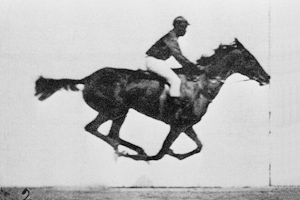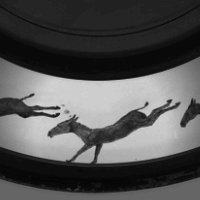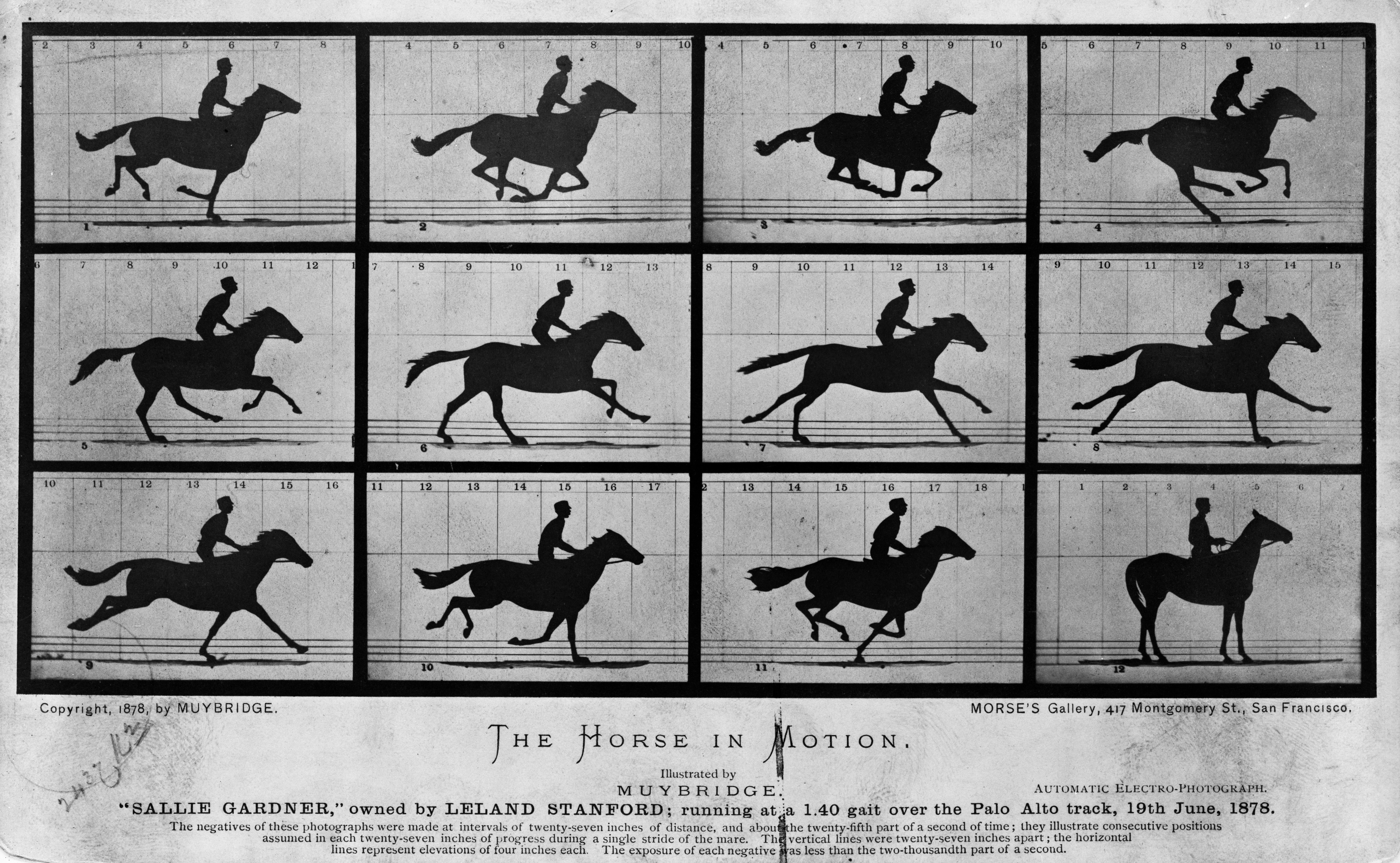|
Zoopraxiscope
The zoopraxiscope (initially named ''zoographiscope'' and ''zoogyroscope'') is an early device for displaying moving images and is considered an important predecessor of the movie projector. It was conceived by photographic pioneer Eadweard Muybridge in 1879 (and built for him by January 1880 to project his famous chronophotographic pictures in motion and thus prove that these were authentic). Muybridge used the projector in his public lectures from 1880 to 1895. The projector used 16" glass disks onto which Muybridge had an unidentified artist paint the sequences as silhouettes. This technique eliminated the backgrounds and enabled the creation of fanciful combinations and additional imaginary elements. Only one disk used photographic images, of a horse skeleton posed in different positions. A later series of 12″ discs, made in 1892–1894, used outlines drawn by Erwin F. Faber that were printed onto the discs photographically, then colored by hand. These colored discs we ... [...More Info...] [...Related Items...] OR: [Wikipedia] [Google] [Baidu] |
Eadweard Muybridge
Eadweard Muybridge ( ; 9 April 1830 – 8 May 1904, born Edward James Muggeridge) was an English photographer known for his pioneering work in photographic studies of motion, and early work in motion-picture Movie projector, projection. He adopted the first name "Eadweard" as the original Germanic name, Anglo-Saxon form of "Edward", and the surname "Muybridge", believing it to be similarly archaic. A photographer in the 19th century American West, he photographed Yosemite National Park, Yosemite, San Francisco, the newly acquired Alaska, Alaskan Territory, subjects involved in the Modoc War, and lighthouses on the West Coast of the United States, West Coast. He also made his early moving picture studies in California. Born in Kingston upon Thames, Surrey, England, at the age of 20 he emigrated to the United States as a bookseller, first to New York City, then to San Francisco. In 1860, he planned a return trip to Europe, but suffered serious head injuries en route in a sta ... [...More Info...] [...Related Items...] OR: [Wikipedia] [Google] [Baidu] |
Zoopraxiscope 16485u
The zoopraxiscope (initially named ''zoographiscope'' and ''zoogyroscope'') is an early device for displaying moving images and is considered an important predecessor of the movie projector. It was conceived by photographic pioneer Eadweard Muybridge in 1879 (and built for him by January 1880 to project his famous chronophotographic pictures in motion and thus prove that these were authentic). Muybridge used the projector in his public lectures from 1880 to 1895. The projector used 16" glass disks onto which Muybridge had an unidentified artist paint the sequences as silhouettes. This technique eliminated the backgrounds and enabled the creation of fanciful combinations and additional imaginary elements. Only one disk used photographic images, of a horse skeleton posed in different positions. A later series of 12″ discs, made in 1892–1894, used outlines drawn by Erwin F. Faber that were printed onto the discs photographically, then colored by hand. These colored discs were ... [...More Info...] [...Related Items...] OR: [Wikipedia] [Google] [Baidu] |
Kingston Museum
Kingston Museum is an accredited museumKingston Museum's unique Accreditation Reference Number is 98, and the museum is included in the database of museums accredited under the Museum Accreditation SchemMuseum Accreditation Scheme – Arts Council England/ref> in Kingston upon Thames, southwest London, England. The Scottish-American philanthropist Andrew Carnegie funded the building of the museum, which adjoins Kingston Library. The museum runs a programme of temporary exhibitions and events; entry is free of charge. Built in 1904, the museum has three permanent exhibitions: "Ancient Origins" details the borough's past from prehistory to Anglo-Saxon times; "Town of Kings" charts Kingston's development as a market town from the medieval period until the 1940s; and "Eadweard Muybridge" presents material related to the noted photographer, a native of Kingston. Description The museum's holdings include 120 Martin Brothers , Martinware ceramics, some of which are on display. The Bri ... [...More Info...] [...Related Items...] OR: [Wikipedia] [Google] [Baidu] |
Phenakistiscope
The phenakistiscope (also known by the spellings phénakisticope or phenakistoscope) was the first widespread animation device that created a fluid illusion of motion. Dubbed and ('stroboscopic discs') by its inventors, it has been known under many other names until the French product name became common (with alternative spellings). The phenakistiscope is regarded as one of the first forms of moving media entertainment that paved the way for the future motion picture and film industry. Similar to a GIF animation, it can only show a short continuous loop. Etymology and spelling When it was introduced in the French newspaper in June 1833, the term 'phénakisticope' was explained to be from the root Greek word ''phenakistikos'' (or rather from φενακίζειν ''phenakizein''), meaning "deceiving" or "cheating", and ὄψ ''óps'', meaning "eye" or "face", so it was probably intended loosely as 'optical deception' or 'optical illusion'. The term phénakisticope was f ... [...More Info...] [...Related Items...] OR: [Wikipedia] [Google] [Baidu] |
Kinetoscope
The Kinetoscope is an early motion picture exhibition device, designed for films to be viewed by one person at a time through a peephole viewer window. The Kinetoscope was not a movie projector, but it introduced the basic approach that would become the standard for all cinematic projection before the advent of video: it created the illusion of movement by conveying a strip of perforated film bearing sequential images over a light source with a high-speed shutter. First described in conceptual terms by U.S. inventor Thomas Edison in 1888, it was largely developed by his employee William Kennedy Laurie Dickson between 1889 and 1892. Dickson and his team at the Edison lab in New Jersey also devised the Kinetograph, an innovative motion picture camera with rapid intermittent, or stop-and-go, film movement, to photograph movies for in-house experiments and, eventually, commercial Kinetoscope presentations. A Kinetoscope prototype was first semipublicly demonstrated to members ... [...More Info...] [...Related Items...] OR: [Wikipedia] [Google] [Baidu] |
Film And Video Technology
A film, also known as a movie or motion picture, is a work of visual art that simulates experiences and otherwise communicates ideas, stories, perceptions, emotions, or atmosphere through the use of moving images that are generally, since the 1930s, synchronized with sound and (less commonly) other sensory stimulations. Etymology and alternative terms The name "film" originally referred to the thin layer of photochemical emulsion on the celluloid strip that used to be the actual medium for recording and displaying motion pictures. Many other terms exist for an individual motion-picture, including "picture", "picture show", "moving picture", "photoplay", and "flick". The most common term in the United States is "movie", while in Europe, "film" is preferred. Archaic terms include "animated pictures" and "animated photography". "Flick" is, in general a slang term, first recorded in 1926. It originates in the verb flicker, owing to the flickering appearance of early films. ... [...More Info...] [...Related Items...] OR: [Wikipedia] [Google] [Baidu] |
Movie Projector
A movie projector (or film projector) is an optics, opto-mechanics, mechanical device for displaying Film, motion picture film by projecting it onto a movie screen, screen. Most of the optical and mechanical elements, except for the illumination and sound devices, are present in movie cameras. Modern movie projectors are specially built video projectors (see also digital cinema). Many projectors are specific to a particular film gauge and not all movie projectors are film projectors since the use of film is required. Predecessors The main precursor to the movie projector was the magic lantern. In its most common setup it had a concave mirror behind a light source to help direct as much light as possible through a painted glass picture slide and a lens, out of the lantern onto a screen. Simple mechanics to have the painted images moving were probably implemented since Christiaan Huygens introduced the apparatus around 1659. Initially, candles and oil lamps were used, but oth ... [...More Info...] [...Related Items...] OR: [Wikipedia] [Google] [Baidu] |
Chronophotography
Chronophotography is a photographic technique from the Victorian era which captures a number of phases of movements. The best known chronophotography works were mostly intended for the scientific study of Animal locomotion, locomotion, to discover practical information for animal handlers and/or as reference material for artists. Although many results were not intended to be exhibited as moving pictures, there is much overlap with the more or less simultaneous quest to register and exhibit photographic motion pictures. Definition Chronophotography is defined as "a set of photographs of a moving object, taken for the purpose of recording and exhibiting successive phases of motion". The term ''chronophotography'' was coined by French physiologist Étienne-Jules Marey to describe photographs of movement from which measurements could be taken and motion could be studied. It is derived from the Greek word χρόνος ''chronos, chrónos'' ("time") combined with ''photography''.The ... [...More Info...] [...Related Items...] OR: [Wikipedia] [Google] [Baidu] |
World's Columbian Exposition
The World's Columbian Exposition, also known as the Chicago World's Fair, was a world's fair held in Chicago from May 5 to October 31, 1893, to celebrate the 400th anniversary of Christopher Columbus's arrival in the New World in 1492. The centerpiece of the Fair, held in Jackson Park, was a large water pool representing the voyage that Columbus took to the New World. Chicago won the right to host the fair over several competing cities, including New York City, Washington, D.C., and St. Louis. The exposition was an influential social and cultural event and had a profound effect on American architecture, the arts, American industrial optimism, and Chicago's image. The layout of the Chicago Columbian Exposition was predominantly designed by John Wellborn Root, Daniel Burnham, Frederick Law Olmsted, and Charles B. Atwood. It was the prototype of what Burnham and his colleagues thought a city should be. It was designed to follow Beaux-Arts principles of design, namely ne ... [...More Info...] [...Related Items...] OR: [Wikipedia] [Google] [Baidu] |
Photography
Photography is the visual arts, art, application, and practice of creating images by recording light, either electronically by means of an image sensor, or chemically by means of a light-sensitive material such as photographic film. It is employed in many fields of science, manufacturing (e.g., photolithography), and business, as well as its more direct uses for art, film and video production, recreational purposes, hobby, and mass communication. A person who operates a camera to capture or take Photograph, photographs is called a photographer, while the captured image, also known as a photograph, is the result produced by the camera. Typically, a lens is used to focus (optics), focus the light reflected or emitted from objects into a real image on the light-sensitive surface inside a camera during a timed Exposure (photography), exposure. With an electronic image sensor, this produces an Charge-coupled device, electrical charge at each pixel, which is Image processing, electro ... [...More Info...] [...Related Items...] OR: [Wikipedia] [Google] [Baidu] |
History Of Cinema
The history of film chronicles the development of a visual art form created using film technologies that began in the late 19th century. The advent of film as an artistic medium is not clearly defined. There were earlier cinematographic screenings by others like the first showing of life sized pictures in motion 1894 in Berlin by Ottomar Anschütz; however, the commercial, public screening of ten Lumière brothers' short films in Paris on 28 December 1895, can be regarded as the breakthrough of projected cinematographic motion pictures. The earliest films were in black and white, under a minute long, without recorded sound, and consisted of a single shot from a steady camera. The first decade saw film move from a novelty, to an established mass entertainment industry, with film production companies and studios established throughout the world. Conventions toward a general cinematic language developed, with film editing, camera movements and other cinematic techniques contribut ... [...More Info...] [...Related Items...] OR: [Wikipedia] [Google] [Baidu] |








